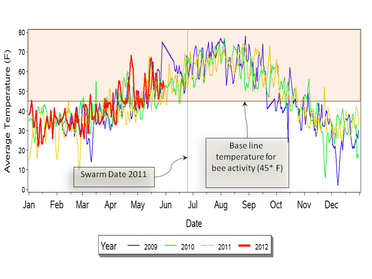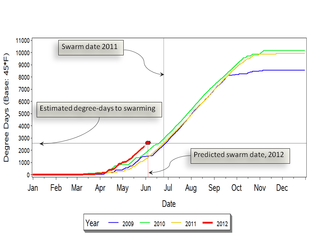Time. We think of it in hours days and weeks. The bees, of course, have no such calendar system. They seem to follow another more intrinsic schedule. This too, however, is a misnomer. Bees, instead, simply grow and develop according to what the environment around them provides. Because they are cold blooded animals, they depend on the environment for warmth. Although they can purposefully generate heat for themselves in the hive, outside of that enclave, they are at the mercy of the elements. Likewise, the resources they take from the environment, nectar and pollen, come from sources, plants, which also depend on the surrounding environment for warmth. As winter moves to spring and then on to fall, the ambient temperature rises and falls.

This plot shows the average temperature for the last three years and the current year in Deary. Although the rising and falling pattern is evident, a lot of shorter term daily and weekly variability is present to. For bees, the critical temperature comes in at about 45*F. Anything below this and they will be static, in a thermal stupor, unable to move. Once the temperature climbs above 45, they will become active. The hotter it gets, the more active they will be. On the plot, I have highlighted the portion above 45*. This is what the bees use. To measure their “time” then, we need to figure out how much time and to what degree (literally) they have been above that temperature.

Such a measure, commonly used by biologists, is called degreedays. There are various ways of calculating degreedays, but a simple quick and dirty method is to just add up the average temperatures, accumulating them over the days of the year. Any averages below the magic 45* level are set to zero. At such temperatures, the bees get nothing from the environment. A plot of these degreedays is shown here. We now have a common scale to compare years. In cool years, such as 2011, the degreedays accumulate slowly at first. Warmer years like 2010, go up faster. At any given degreeday level, the bees have received equivalent amounts of energy from the environment, and by implication should be at similar stages of development.
I have a particular point of development in mind: The infamous time of swarming. I know the date this occurred in 2011 and can infer from this the degreedays needed to achieve that. It turns out to be about 2500. Hence, thoughout the current season, I have been watching the degreedays build and climb towards the 2500 mark. We are getting close now. And my little trick of math and weather seems to be playing out. The last couple of days, I have noticed the bees suddenly becoming active at about 1:00-2:00 in the afternoon (the timing is always very close to this). They swirl out of the hive and buzz in wide circles around they hive. Many will also come out and crawl on the face of the hive. It is very loud, easily discernible, even from the front yard. They don’t actually swarm, but I believe these are trial runs, practice if you will, as they prepare for the event. So it looks like the degreeday model may work. Unfortunately, if you trace the red line up into the future, it looks like things may happen when a certain someone is getting married and we are away for the weekend, so alas, the best laid plans and predictions may be foiled. Still, I was pleased to see things get this close. There’s always next year!
 RSS Feed
RSS Feed